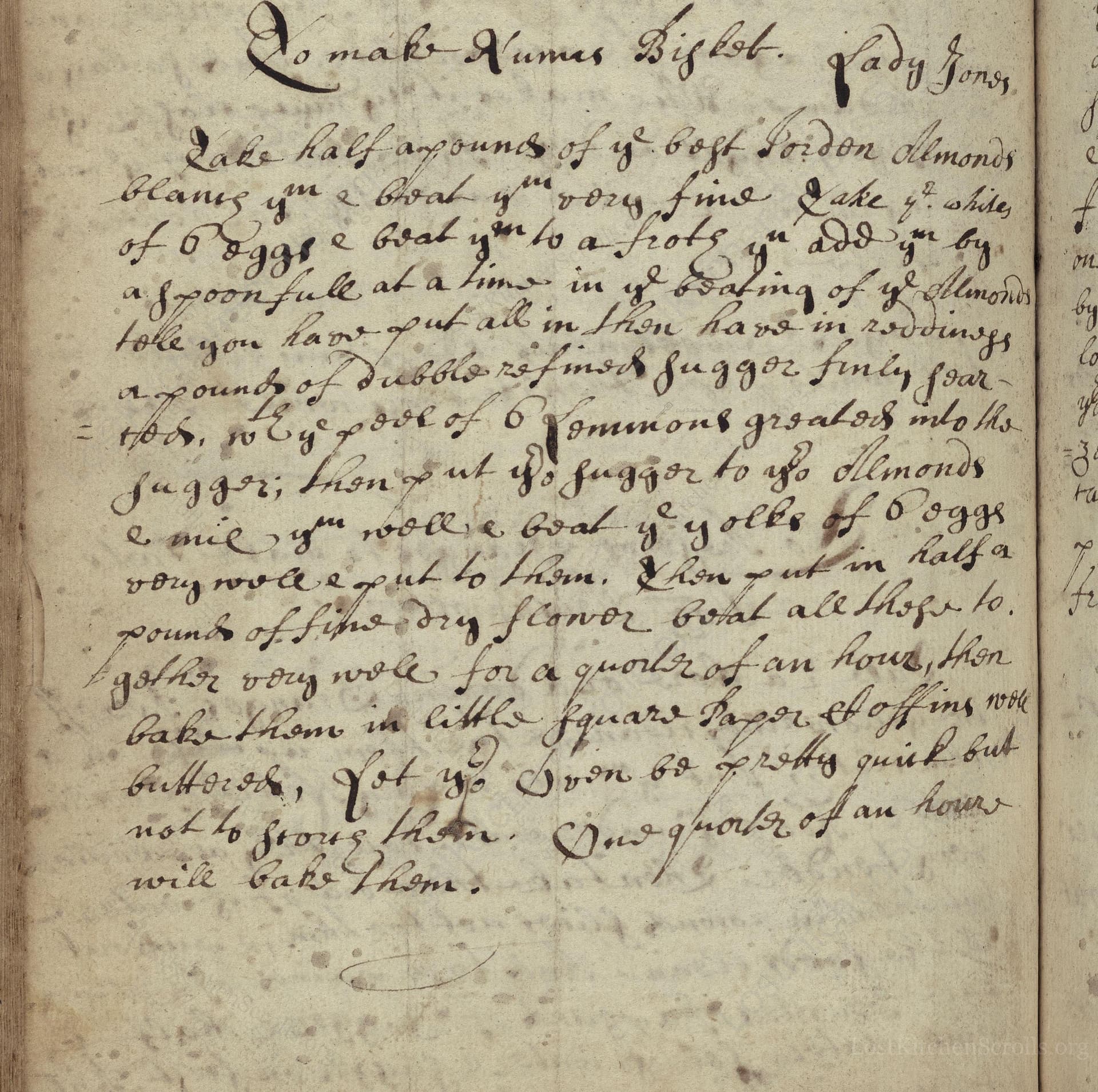To Make Numes Bisket Lady Jones
From the treasured pages of Receipt book of Penelope Jephson
Written by Penelope Patrick

To Make Numes Bisket Lady Jones
"Take half a pound of ye best Jordon Almonds blan[ch] you & beat ym very fine. take ye white of 6 Eggs & beat ym to a froth, yn add ym by a spoonfull at a time in ye beating of ye Almonds. till you have put all in, then have in rediness a pound & of dubble refined sugger finely searsed. take ye peele of 6 Lemmons greated into the sugger; then put ye sugger to ye almonds & mix you well. & beat ye yolke of 6 eggs very well & put to them. then put in half a pound of fine dry flower beat all these together very well. for a quarter of an hower, then bake them in little square paper coffins well butterred, let ye Oven be pretty quick but not to strong haten. One quarter of an houer will bake them."
Note on the Original Text
This recipe is written in the typical style of the late seventeenth century: minimal punctuation, freeform narrative, and using both phonetic and archaic spelling (e.g., 'sugger' for sugar, 'greated' for grated, 'flower' for flour, 'hower' for hour). Quantities are sometimes ambiguous, as weights and measures were becoming standardized but still varied by household. The method expects the cook to have a firm grasp of technique, such as testing oven temperature by feel and adjusting beating time intuitively. The spelling, grammar, and sentence structure reflect the period's conventions—'yn' meaning 'then', 'ym' for 'them', and the ampersand (&) used in place of 'and' for speed. This gives us insight into both literacy and transmission of culinary knowledge among literate, elite women.

Title
Receipt book of Penelope Jephson (1673)
You can also click the book image above to peruse the original tome
Writer
Penelope Patrick
Era
1673
Publisher
Unknown
Background
Step back into the sumptuous kitchens of the late 17th century with Penelope Patrick’s culinary collection—a feast of historic recipes, secret tips, and the irresistible flavors of Restoration England all bound together in a handwritten treasure.
Kindly made available by
Folger Shakespeare Library
This recipe hails from the handwritten collection of Penelope Patrick, Lady Jones, dated between 1671 and 1675. Recipes like 'Numes Bisket' (an early almond biscuit or cake) were popular in aristocratic English households of the late seventeenth century. Their ingredients—almonds and refined sugar—were luxury imports, signifying status and wealth. Such confections were often served at banquets or alongside syllabubs and other sweetmeats, delighting guests with their delicate flavor and fine lemon scent.

Lady Jones would have used a mortar and pestle to grind the almonds finely and a coarse sieve for sifting sugar. Eggs were beaten with a birch or willow whisk, and ingredients mixed in large ceramic or wooden bowls. Baking was done in a free-standing, wood-fired oven, the heat tested by experience. The batter was portioned into small paper 'coffins'—an early form of baking cup—brushed with butter to prevent sticking.
Prep Time
30 mins
Cook Time
15 mins
Servings
18
We've done our best to adapt this historical recipe for modern kitchens, but some details may still need refinement. We warmly welcome feedback from fellow cooks and culinary historians — your insights support the entire community!
Ingredients
- 8 oz Jordan almonds (blanched and finely ground)
- 6 egg whites
- 1 lb caster (superfine) sugar
- Zest of 6 lemons
- 6 egg yolks
- 8 oz plain (all-purpose) flour
- Butter, for greasing paper cups
- Small square paper baking cups (or muffin liners as substitute)
Instructions
- To make Lady Jones's 'Numes Bisket', begin by blanching 8 ounces of the finest Jordan almonds and grinding them finely in a food processor or mortar and pestle.
- Whisk the whites of 6 large eggs until they are frothy, then gradually beat them into the ground almonds, one spoonful at a time.
- Separately, zest 6 lemons and blend the zest into 1 pound of superfine (caster) sugar.
- Add this fragrant sugar to the almond mixture and combine thoroughly.
- In another bowl, beat the yolks of 6 eggs until smooth, then add to the almond-sugar blend.
- Now, sift in 8 ounces of plain flour and mix.
- Beat the combined batter vigorously for about 15 minutes to achieve a smooth, aerated consistency.
- Prepare small square muffin cups ('little square paper coffins') by buttering them well, and fill them with the mixture.
- Bake in a preheated oven at 350°F (180°C), for about 15 minutes, or until just set and lightly golden.
Estimated Calories
250 per serving
Cooking Estimates
Preparing this recipe takes about 30 minutes, including grinding almonds, beating eggs, zesting lemons, and mixing ingredients. Baking takes another 15 minutes, until the cakes are set and lightly golden. Each serving contains about 250 calories, and the recipe yields 18 small cakes.
As noted above, we have made our best effort to translate and adapt this historical recipe for modern kitchens, taking into account ingredients nowadays, cooking techniques, measurements, and so on. However, historical recipes often contain assumptions that require interpretation.
We'd love for anyone to help improve these adaptations. Community contributions are highly welcome. If you have suggestions, corrections, or cooking tips based on your experience with this recipe, please share them below.
Join the Discussion
Rate This Recipe
Dietary Preference
Culinary Technique

Den Bockfisch In Einer Fleisch Suppen Zu Kochen
This recipe hails from a German manuscript cookbook compiled in 1696, a time whe...

Die Grieß Nudlen Zumachen
This recipe comes from a rather mysterious manuscript cookbook, penned anonymous...

Ein Boudain
This recipe comes from an anonymous German-language manuscript cookbook from 169...

Ein Gesaltzen Citroni
This recipe, dating from 1696, comes from an extensive anonymous German cookbook...
Browse our complete collection of time-honored recipes



